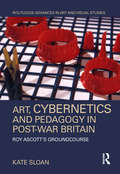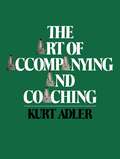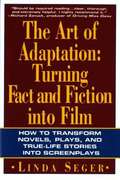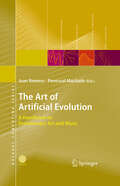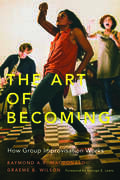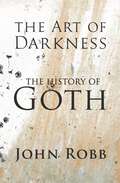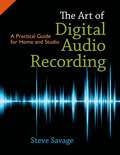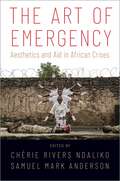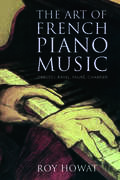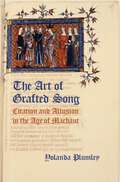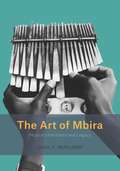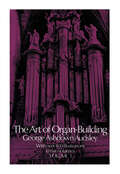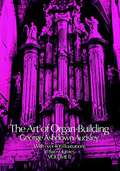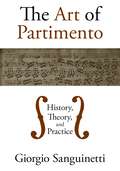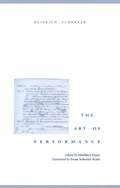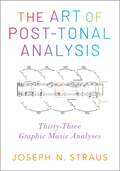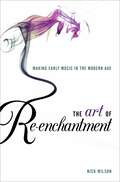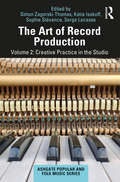- Table View
- List View
Art, Cybernetics and Pedagogy in Post-War Britain: Roy Ascott’s Groundcourse (Routledge Advances in Art and Visual Studies)
by Kate SloanThis is the first full-length study about the British artist Roy Ascott, one of the first cybernetic artists, with a career spanning seven decades to date. The book focuses on his early career, exploring the evolution of his early interests in communication in the context of the rich overlaps between art, science and engineering in Britain during the 1950s and 1960s. The first part of the book looks at Ascott’s training and early work. The second park looks solely at Groundcourse, Ascott’s extraordinary pedagogical model for visual arts and cybernetics which used an integrative and systems-based model, drawing in behaviourism, analogue machines, performance and games. Using hitherto unpublished photographs and documents, this book will establish a more prominent place for cybernetics in post-war British art.
The Art of Accompanying and Coaching
by Kurt AdlerIN WRITING a book for which there is no precedent (the tistic achievements. But, alas, there has not been such last textbooks about accompanying were written during a genius in the realm of music during the twentieth the age of thorough bass or shortly thereafter - the century. The creative musical genius of our space age eighteenth and early nineteenth centuries - and dealt has yet to be discovered, if he has been born. exclusively with the problems timely then) one must Our time has perfected technique to such a degree make one's own rules and set one's own standards. This that it could not help but create perfect technician freedom makes the task somewhat easier, if, on the one artists. Our leading creative artists master technique hand, one looks to the past: there is no generally ap to the point of being able to shift from one style to proved model to be followed and to be compared with another without difficulty. Take Stravinsky and Picasso, one's work; but, on the other hand, the task is hard be for instance: they have gone back and forth through as cause one's responsibility to present and future genera many periods of style as they wished. Only with a stu tions of accompanists and coaches is great.
The Art of Adaptation: Turning Fact and Fiction into Film (PDF)
by Linda SegerAdaptations have long been a mainstay of Hollywood and the television networks. Indeed, most Academy Award- and Emmy Award-winning films have been adaptations of novels, plays, or true-life stories. Linda Seger, author of two acclaimed books on scriptwriting, now offers a comprehensive handbook for screenwriters, producers, and directors who want to successfully transform fictional or factual material into film. Seger tells how to analyze source material to understand why some of it resists adaptation. She then gives practical methods for translating story, characters, themes, and style into film. A final section details essential information on how to adapt material and how to protect oneself legally
The Art of Artificial Evolution: A Handbook on Evolutionary Art and Music (Natural Computing Series)
by Juan J. Romero Penousal MachadoThis comprehensive book gives an up-to-date survey of the relevant bioinspired computing research fields – such as evolutionary computation, artificial life, swarm intelligence and ant colony algorithms – and examines applications in art, music and design. The editors and contributors are researchers and artists with deep experience of the related science, tools and applications, and the book includes overviews of historical developments and future perspectives.
The Art of Becoming: How Group Improvisation Works
by Raymond A. MacDonald Graeme B. WilsonAt a time of unprecedented interest in improvisation across the arts, The Art of Becoming boldly asserts that everyone can and should improvise. Drawing on emerging psychological literature as well as their own research with musicians, authors Raymond MacDonald and Graeme Wilson - both music psychologists and renowned performers in their own right - propose new ideas on what defines improvisation in music. MacDonald and Wilson explore the cognitive processes involved, the role of specialist skills or knowledge in improvised interaction, and the nature of understanding between improvisers. Their investigation lays out how we develop as improvisers, alongside health benefits derived from music participation. The Art of Becoming is a vital resource for courses on improvisation in contemporary practice, and for those applying musical improvisation in community and therapeutic contexts, setting out a framework based on psychological findings for understanding improvisation as a universal capability and an essentially social behavior. With suggestions for approaching this practice in new ways at any level, it demonstrates how improvisation transcends musical genres and facilitates collaboration between practitioners from disciplines across the artistic spectrum. Putting forward important implications for contemporary artistic practices, pedagogy, music therapy and the psychology of social behavior, The Art of Becoming provides fresh and provocative insights for anyone interested in playing, studying, teaching, or listening to improvised music.
ART OF BECOMING C: How Group Improvisation Works
by Raymond A. MacDonald Graeme B. WilsonAt a time of unprecedented interest in improvisation across the arts, The Art of Becoming boldly asserts that everyone can and should improvise. Drawing on emerging psychological literature as well as their own research with musicians, authors Raymond MacDonald and Graeme Wilson - both music psychologists and renowned performers in their own right - propose new ideas on what defines improvisation in music. MacDonald and Wilson explore the cognitive processes involved, the role of specialist skills or knowledge in improvised interaction, and the nature of understanding between improvisers. Their investigation lays out how we develop as improvisers, alongside health benefits derived from music participation. The Art of Becoming is a vital resource for courses on improvisation in contemporary practice, and for those applying musical improvisation in community and therapeutic contexts, setting out a framework based on psychological findings for understanding improvisation as a universal capability and an essentially social behavior. With suggestions for approaching this practice in new ways at any level, it demonstrates how improvisation transcends musical genres and facilitates collaboration between practitioners from disciplines across the artistic spectrum. Putting forward important implications for contemporary artistic practices, pedagogy, music therapy and the psychology of social behavior, The Art of Becoming provides fresh and provocative insights for anyone interested in playing, studying, teaching, or listening to improvised music.
The Art of Darkness: The History of Goth
by John RobbThis is the first comprehensive history of goth music and culture. Across more than 500 pages, John Robb explores the origins and legacy of this enduring scene, which has its roots in the post-punk era.Drawing on his own experience as a musician and journalist, Robb covers the style, the music and the clubs that spawned the culture, alongside political and social conditions. He also reaches back further to key historic events and movements that frame the ideas of goth, from the fall of Rome to Lord Byron and the romantic poets, European folk tales, Gothic art and the occult. Finally, he considers the current mainstream goth of Instagram influencers, film, literature and music.The Art of Darkness features interviews with Siouxsie and the Banshees, The Cure, The Damned, Nick Cave, Southern Death Cult, Einstürzende Neubauten, Bauhaus, Killing Joke, Throbbing Gristle, Danielle Dax, Lydia Lunch and many more. It offers a first-hand account of being there at the gigs and clubs that made the scene happen.
The Art of Darkness: The History of Goth (G - Reference,information And Interdisciplinary Subjects Ser.)
by John RobbThis is the first comprehensive history of goth music and culture. Across more than 500 pages, John Robb explores the origins and legacy of this enduring scene, which has its roots in the post-punk era.Drawing on his own experience as a musician and journalist, Robb covers the style, the music and the clubs that spawned the culture, alongside political and social conditions. He also reaches back further to key historic events and movements that frame the ideas of goth, from the fall of Rome to Lord Byron and the romantic poets, European folk tales, Gothic art and the occult. Finally, he considers the current mainstream goth of Instagram influencers, film, literature and music.The Art of Darkness features interviews with Siouxsie and the Banshees, The Cure, The Damned, Nick Cave, Southern Death Cult, Einstürzende Neubauten, Bauhaus, Killing Joke, Throbbing Gristle, Danielle Dax, Lydia Lunch and many more. It offers a first-hand account of being there at the gigs and clubs that made the scene happen.
The Art of Digital Audio Recording: A Practical Guide for Home and Studio
by Steve SavageMaking great audio recordings requires striking the right balance between technical know-how and practical understanding of recording sessions. Even in the digital age, some of the most important aspects of creating and recording music are non-technical and, as a result, are often overlooked by traditional recording manuals. The Art of Digital Audio Recording teaches readers what they really need to know in order to make great sound recordings with computers - both the practical and the technical information, including: · What to look and listen for in a recording environment · Straightforward advice on recording almost any instrument · Essentials of digital audio workstations · Essentials of recording gear: microphones, mixers, and speakers · Fundamentals of understanding and applying EQ, compression, delay, and reverb · Secrets to running creative recording sessions · Practical application of digital editing, mixing, and mastering A special section identifies solutions to the most common challenges in the recording studio, and the book also features an addendum with essential tips and reference information including: · How to walk into a commercial studio and be the engineer · Researching and buying gear: Internet vs. brick and mortar · Digital formats: A handy reference As a whole, The Art of Digital Audio Recording is an essential resource that gives recordists the tools they need to let technical understanding serve greater musical goals.
The Art of Digital Audio Recording: A Practical Guide for Home and Studio
by Steve SavageMaking great audio recordings requires striking the right balance between technical know-how and practical understanding of recording sessions. Even in the digital age, some of the most important aspects of creating and recording music are non-technical and, as a result, are often overlooked by traditional recording manuals. The Art of Digital Audio Recording teaches readers what they really need to know in order to make great sound recordings with computers - both the practical and the technical information, including: · What to look and listen for in a recording environment · Straightforward advice on recording almost any instrument · Essentials of digital audio workstations · Essentials of recording gear: microphones, mixers, and speakers · Fundamentals of understanding and applying EQ, compression, delay, and reverb · Secrets to running creative recording sessions · Practical application of digital editing, mixing, and mastering A special section identifies solutions to the most common challenges in the recording studio, and the book also features an addendum with essential tips and reference information including: · How to walk into a commercial studio and be the engineer · Researching and buying gear: Internet vs. brick and mortar · Digital formats: A handy reference As a whole, The Art of Digital Audio Recording is an essential resource that gives recordists the tools they need to let technical understanding serve greater musical goals.
The Art of Emergency: Aesthetics and Aid in African Crises
The Art of Emergency charts the maneuvers of art through conflict zones across the African continent. Advancing diverse models for artistic and humanitarian alliance, the volume urges conscientious deliberation on the role of aesthetics in crisis through intellectual engagement, artistic innovation, and administrative policy. Across Africa, artists increasingly turn to NGO sponsorship in pursuit of greater influence and funding, while simultaneously NGOs-both international and local-commission arts projects to buttress their interventions and achieve greater reach and marketability. The key values of artistic expression thus become "healing" and "sensitization," measured in turn by "impact" and "effectiveness." Such rubrics obscure the aesthetic complexities of the artworks and the power dynamics that inform their production. Clashes arise as foreign NGOs import foreign aesthetic models and preconceptions about their efficacy, alongside foreign interpretations of politics, medicine, psychology, trauma, memorialization, and so on. Meanwhile, each community embraces its own aesthetic precedents, often at odds with the intentions of humanitarian agencies. The arts are a sphere in which different worldviews enter into conflict and conversation. To tackle the consequences of aid agency arts deployment, volume editors Samuel Mark Anderson and Chérie Rivers Ndaliko assemble ten case studies from across the African continent employing multiple media including music, sculpture, photography, drama, storytelling, ritual, and protest marches. Organized under three widespread yet under-analyzed objectives for arts in emergency-demonstration, distribution, and remediation-each case offers a different disciplinary and methodological perspective on a common complication in NGO-sponsored creativity. By shifting the discourse on arts activism away from fixations on message and toward diverse investigations of aesthetics and power negotiations, The Art of Emergency brings into focus the conscious and unconscious configurations of humanitarian activism, the social lives it attempts to engage, and the often-fraught interactions between the two.
ART OF EMERGENCY C: Aesthetics and Aid in African Crises
by Chérie Rivers Ndaliko and Samuel Mark AndersonThe Art of Emergency charts the maneuvers of art through conflict zones across the African continent. Advancing diverse models for artistic and humanitarian alliance, the volume urges conscientious deliberation on the role of aesthetics in crisis through intellectual engagement, artistic innovation, and administrative policy. Across Africa, artists increasingly turn to NGO sponsorship in pursuit of greater influence and funding, while simultaneously NGOs-both international and local-commission arts projects to buttress their interventions and achieve greater reach and marketability. The key values of artistic expression thus become "healing" and "sensitization," measured in turn by "impact" and "effectiveness." Such rubrics obscure the aesthetic complexities of the artworks and the power dynamics that inform their production. Clashes arise as foreign NGOs import foreign aesthetic models and preconceptions about their efficacy, alongside foreign interpretations of politics, medicine, psychology, trauma, memorialization, and so on. Meanwhile, each community embraces its own aesthetic precedents, often at odds with the intentions of humanitarian agencies. The arts are a sphere in which different worldviews enter into conflict and conversation. To tackle the consequences of aid agency arts deployment, volume editors Samuel Mark Anderson and Chérie Rivers Ndaliko assemble ten case studies from across the African continent employing multiple media including music, sculpture, photography, drama, storytelling, ritual, and protest marches. Organized under three widespread yet under-analyzed objectives for arts in emergency-demonstration, distribution, and remediation-each case offers a different disciplinary and methodological perspective on a common complication in NGO-sponsored creativity. By shifting the discourse on arts activism away from fixations on message and toward diverse investigations of aesthetics and power negotiations, The Art of Emergency brings into focus the conscious and unconscious configurations of humanitarian activism, the social lives it attempts to engage, and the often-fraught interactions between the two.
The Art of French Piano Music: Debussy, Ravel, Fauré, Chabrier
by Roy HowatAn essential resource for scholars and performers, this study by a world-renowned specialist illuminates the piano music of four major French composers, in comparative and reciprocal context. Howat explores the musical language and artistic ethos of this repertoire, juxtaposing structural analysis with editorial and performing issues. He also relates his four composers historically and stylistically to such predecessors as Chopin, Schumann, Liszt, the French harpsichord school, and Russian and Spanish music. Challenging long-held assumptions about performance practice, Howat elucidates the rhythmic vitality and invention inherent in French music. In granting Fauré and Chabrier equal consideration with Debussy and Ravel, he redresses a historic imbalance and reshapes our perceptions of this entire musical tradition. Outstanding historical documentation and analysis are supported by Howat’s direct references to performing traditions shaped by the composers themselves. The book balances accessibility with scholarly and analytic rigor, combining a lifetime’s scholarship with practical experience of teaching and the concert platform
The Art of Grafted Song: Citation and Allusion in the Age of Machaut
by Yolanda PlumleyJust as our society delights in citations, quotations, and allusions in myriad contexts, not least in popular song, late medieval poets and composers knew well that such references could greatly enrich their own works. In The Art of the Grafted Song: Citation and Allusion in the Age of Machaut, author Yolanda Plumley explores the penchant for borrowing in chansons and lyrics from fourteenth-century France, uncovering a practice integral to the experiments in form, genre, and style that ushered in a new school of lyric. Working across disciplinary boundaries, Plumley traces creative appropriations in the burgeoning "fixed forms" of this new tradition to build a more intimate understanding of the shared experience of poetry and music in the generations leading up to, and including, Guillaume de Machaut. Exploring familiar and less studied collections of songs as well as lyrics without music, this book sheds valuable light on the poetic and musical knowledge of authors and their audiences, and on how poets and composers devised their works and engaged their readers or listeners. It presents fresh insights into when and in which milieus the classic Ars nova polyphonic chanson took root and flourished, and into the artistic networks of which Machaut formed a part. As Plumley reveals, old songs lingered alongside the new in the collective imagination well beyond what the written sources imply, reminding us of the continued importance of memory and orality in this age of increasing literacy. The first detailed study of citational practice in the French fourteenth-century song-writing tradition, The Art of Grafted Song will appeal to students and scholars of medieval French music and literature, cultural historians, and others interested in the historical and social context of music and poetry in the late Middle Ages.
The Art of Mbira: Musical Inheritance and Legacy (Chicago Studies in Ethnomusicology)
by Paul F. BerlinerGrowing out of the collaborative research of an American ethnomusicologist and Zimbabwean musician, Paul F. Berliner’s The Art of Mbira documents the repertory for a keyboard instrument known generally as mbira. At the heart of this work lies the analysis of the improvisatory processes that propel mbira music’s magnificent creativity. In this book, Berliner provides insight into the communities of study, performance, and worship that surround mbira. He chronicles how master player Cosmas Magaya and his associates have developed their repertory and practices over more than four decades, shaped by musical interaction, social and political dynamics in Zimbabwe, and the global economy of the music industry. At once a detailed exposition of the music’s forms and practices, it is also an indispensable historical and cultural guide to mbira in a changing world. Together with Berliner and Magaya's compendium of mbira compositions, Mbira’s Restless Dance, The Art of Mbira breaks new ground in the depth and specificity of its exploration of an African musical tradition, and in the entwining of the authors’ collaborative voices. It is a testament to the powerful relationship between music and social life—and the rewards of lifelong musical study, performance, and friendship.
The Art of Mbira: Musical Inheritance and Legacy (Chicago Studies in Ethnomusicology)
by Paul F. BerlinerGrowing out of the collaborative research of an American ethnomusicologist and Zimbabwean musician, Paul F. Berliner’s The Art of Mbira documents the repertory for a keyboard instrument known generally as mbira. At the heart of this work lies the analysis of the improvisatory processes that propel mbira music’s magnificent creativity. In this book, Berliner provides insight into the communities of study, performance, and worship that surround mbira. He chronicles how master player Cosmas Magaya and his associates have developed their repertory and practices over more than four decades, shaped by musical interaction, social and political dynamics in Zimbabwe, and the global economy of the music industry. At once a detailed exposition of the music’s forms and practices, it is also an indispensable historical and cultural guide to mbira in a changing world. Together with Berliner and Magaya's compendium of mbira compositions, Mbira’s Restless Dance, The Art of Mbira breaks new ground in the depth and specificity of its exploration of an African musical tradition, and in the entwining of the authors’ collaborative voices. It is a testament to the powerful relationship between music and social life—and the rewards of lifelong musical study, performance, and friendship.
The Art of Mbira: Musical Inheritance and Legacy (Chicago Studies in Ethnomusicology)
by Paul F. BerlinerGrowing out of the collaborative research of an American ethnomusicologist and Zimbabwean musician, Paul F. Berliner’s The Art of Mbira documents the repertory for a keyboard instrument known generally as mbira. At the heart of this work lies the analysis of the improvisatory processes that propel mbira music’s magnificent creativity. In this book, Berliner provides insight into the communities of study, performance, and worship that surround mbira. He chronicles how master player Cosmas Magaya and his associates have developed their repertory and practices over more than four decades, shaped by musical interaction, social and political dynamics in Zimbabwe, and the global economy of the music industry. At once a detailed exposition of the music’s forms and practices, it is also an indispensable historical and cultural guide to mbira in a changing world. Together with Berliner and Magaya's compendium of mbira compositions, Mbira’s Restless Dance, The Art of Mbira breaks new ground in the depth and specificity of its exploration of an African musical tradition, and in the entwining of the authors’ collaborative voices. It is a testament to the powerful relationship between music and social life—and the rewards of lifelong musical study, performance, and friendship.
The Art of Organ Building
by George Ashdown AudsleyVolume 1 of the fullest repository on organ building and history in English language. Includes outline of organ history, external design and decoration, internal arrangement and mechanical systems, acoustics and theories of sound-production in organ pipes, tonal structure and appointment, compound stops of the organ, more. Complete with illustrations, tables, and specifications. "the most significant republication in our field for the past twenty years . . . an incomparable, invaluable book." -- American Guild of Organists Quarterly.
The Art of Organ Building (Dover Books on Music #2)
by George Ashdown AudsleyVolume 2 of the fullest repository on organ building and history in English language. Includes outline of organ history, external design and decoration, internal arrangement and mechanical systems, acoustics and theories of sound-production in organ pipes, tonal structure and appointment, compound stops of the organ, more. Complete with illustrations, tables, and specifications. "...the most significant republication in our field for the past twenty years...an incomparable, invaluable book." — American Guild of Organists Quarterly.
The Art of Partimento: History, Theory, and Practice
by Giorgio SanguinettiAt the height of the Enlightenment, four conservatories in Naples stood at the center of European composition. Maestros taught their students to compose with unprecedented swiftness and elegance using the partimento, an instructional tool derived from the basso continuo that encouraged improvisation as the path to musical fluency. Although the practice vanished in the early nineteenth century, its legacy lived on in the music of the next generation. In The Art of Partimento, performer and music-historian Giorgio Sanguinetti chronicles the history of this long-forgotten Neapolitan art. Sanguinetti has painstakingly reconstructed the oral tradition that accompanied these partimento manuscripts, now scattered throughout Europe. Beginning with the origins of the partimento in the circles of Corelli, Pasquini, and Alessandro Scarlatti in Rome and tracing it through the peak of the tradition in Naples, The Art of Partimento gives a glimpse into the daily life and work of an eighteenth century composer. The Art of the Partimento is also a complete practical handbook to reviving the tradition today. Step by step, Sanguinetti guides the aspiring composer through elementary realization to more advanced exercises in diminution, imitation, and motivic coherence. Based on the teachings of the original masters, Sanguinetti challenges the reader to become a part of history, providing a variety of original partimenti in a range of genres, forms, styles, and difficulty levels along the way and allowing the student to learn the art of the partimento for themselves at their own pace. As both history and practical guide, The Art of Partimento presents a new and innovative way of thinking about music theory. Sanguinetti's unique approach unites musicology and music theory with performance, which allows for a richer and deeper understanding than any one method alone, and offers students and scholars of composition and music theory the opportunity not only to understand the life of this fascinating tradition, but to participate in it as well.
The Art of Performance
by Heinrich SchenkerHeinrich Schenker's The Art of Performance shows this great music theorist in a new light. While his theoretical writings helped transform music theory in the twentieth century, this book draws on his experience as a musician and teacher to propose a sharp reevaluation of how musical compositions are realized in performance. Filled with concrete examples and numerous suggestions, the book will interest both music theorists and practicing performers. Schenker's approach is based on his argument that much of contemporary performance practice is rooted in the nineteenth-century cult of the virtuoso, which has resulted in an overemphasis on technical display. To counter this, he proposes specific ways to reconnect the composer's intentions and the musician's performance. Schenker begins by showing how performers can benefit from understanding the laws of composition. He demonstrates how a literal interpretation of the composer's indications can be self-defeating, and he provides a lively discussion of piano technique, including suggestions for pedal, sound color, orchestral effects, and balance. He devotes separate chapters to non-legato, legato, fingering, dynamics, tempo, and rests. In addition to the examples for pianists, Schenker covers a number of topics, such as bowing technique, that will prove invaluable for other instrumentalists and for conductors. The book concludes with an aphoristic and sometimes lyrical chapter on practicing. After Schenker's death, his student Oswald Jonas prepared the text for publication from Schenker's notes, eventually leaving the manuscript to his stepdaughter, Irene Schreier Scott, who entrusted the work of organizing and editing the disparate material to Jonas's friend and student Heribert Esser. She later translated it into English. This edition is the first publication in any language of this remarkable work.
The Art of Post-Tonal Analysis: Thirty-Three Graphic Music Analyses
by Joseph N. StrausThe Art of Post-Tonal Analysis consists of analyses of thirty-three musical passages or entire short works in a variety of post-tonal styles. For each piece author Joseph N. Straus shows how it is put together and what sense might be made of it: how the music goes. Along the way, he shows the value of post-tonal theory in addressing these questions, and in revealing something of the fascination and beauty of this music. The works under study are taken from throughout the long twentieth century, from 1909 to the present. Within the atonal wing of modern classical music, the composers discussed here, some canonical and some not, represent a diversity of musical style, chronology, geography, gender, and race/ethnicity. Musical examples, plus a companion website full of analytical videos, carry the burden of the analytical argument, with rarely more than a few sentences of prose at a time. In writing these analyses, Straus imagined teaching these pieces to a class of undergraduate or graduate students, seated at the piano, pointing at score, listening as they go--the book is intended as a record of these (hypothetical) classes. His approach could be loosely described as transformational, rooted in an interest in seeing how musical ideas (shapes, intervals, motives) grow, change, and effloresce. When musical ideas are obviously dissimilar and possibly in conflict, the book teases out subtle points of connection between them. Above all, the book aims to create rich networks of relatedness, allowing our musical minds and musical ears to lead each other along some of the many enjoyable pathways through this challenging and beautiful music.
The Art of Post-Tonal Analysis: Thirty-Three Graphic Music Analyses
by Joseph N. StrausThe Art of Post-Tonal Analysis consists of analyses of thirty-three musical passages or entire short works in a variety of post-tonal styles. For each piece author Joseph N. Straus shows how it is put together and what sense might be made of it: how the music goes. Along the way, he shows the value of post-tonal theory in addressing these questions, and in revealing something of the fascination and beauty of this music. The works under study are taken from throughout the long twentieth century, from 1909 to the present. Within the atonal wing of modern classical music, the composers discussed here, some canonical and some not, represent a diversity of musical style, chronology, geography, gender, and race/ethnicity. Musical examples, plus a companion website full of analytical videos, carry the burden of the analytical argument, with rarely more than a few sentences of prose at a time. In writing these analyses, Straus imagined teaching these pieces to a class of undergraduate or graduate students, seated at the piano, pointing at score, listening as they go--the book is intended as a record of these (hypothetical) classes. His approach could be loosely described as transformational, rooted in an interest in seeing how musical ideas (shapes, intervals, motives) grow, change, and effloresce. When musical ideas are obviously dissimilar and possibly in conflict, the book teases out subtle points of connection between them. Above all, the book aims to create rich networks of relatedness, allowing our musical minds and musical ears to lead each other along some of the many enjoyable pathways through this challenging and beautiful music.
The Art of Re-enchantment: Making Early Music in the Modern Age
by Nick WilsonIn the late 1960s, a new movement emerged championing historically informed 'authentic' approaches to performance. Heard today in concert halls across the world and in a library's worth of recordings, it has completely transformed the way in which we listen to 'old' music, while revolutionizing the classical music profession in the process. Yet the rise of Early Music has been anything but uncontroversial. Historically informed performance (HIP) has provoked heated debate amongst musicologists, performers and cultural sociologists. Did HIP's scholar-performers possess the skills necessary to achieve their uncompromising agenda? Was interest in historically informed performance just another facet of the burgeoning heritage industry? And was the widespread promotion of early music simply a commercial ruse to make money put forward by profit-driven record companies? In The Art of Re-enchantment: Making Early Music in the Modern Age, author Nick Wilson answers these and other questions through an in-depth analysis of the early music movement in Britain from the 1960s to the present day. While other books have examined the history of early music's revival, this interdisciplinary study is unique in its focus on how various constituencies actually made their living from the early music business. Through chapters discussing the professionalization of early music, the influence of institutions such as the BBC and record companies, and the entrepreneurial role of leading early music pioneers, this book will shed new light on one of the most fascinating and influential movements in 20th Century art music. The Art of Re-enchantment begins a much-needed conversation about the true value of art and authenticity today. This volume is a must have for early music fans and performers, music historians and musicologists with an interest in performance practice, and anyone interested in the production, distribution and consumption of music.
The Art of Record Production: Creative Practice in the Studio (Ashgate Popular and Folk Music Series)
by Simon Zagorski-Thomas Katia Isakoff Serge Lacasse Sophie StévanceThe playback of recordings is the primary means of experiencing music in contemporary society, and in recent years 'classical' musicologists and popular music theorists have begun to examine the ways in which the production of recordings affects not just the sound of the final product but also musical aesthetics more generally. Record production can, indeed, be treated as part of the creative process of composition. At the same time, training in the use of these forms of technology has moved from an apprentice-based system into university education. Musical education and music research are thus intersecting to produce a new academic field: the history and analysis of the production of recorded music. This book is designed as a general introductory reader, a text book for undergraduate degree courses studying the creative processes involved in the production of recorded music. The aim is to introduce students to the variety of approaches and methodologies that are currently being employed by scholars in this field. The book is divided into three sections covering historical approaches, theoretical approaches and case studies and practice. There are also three interludes of commentary on the academic contributions from leading record producers and other industry professionals. This collection gives students and scholars a broad overview of the way in which academics from the analytical and practice-based areas of the university system can be brought together with industry professionals to explore the ways in which this new academic field should progress.
